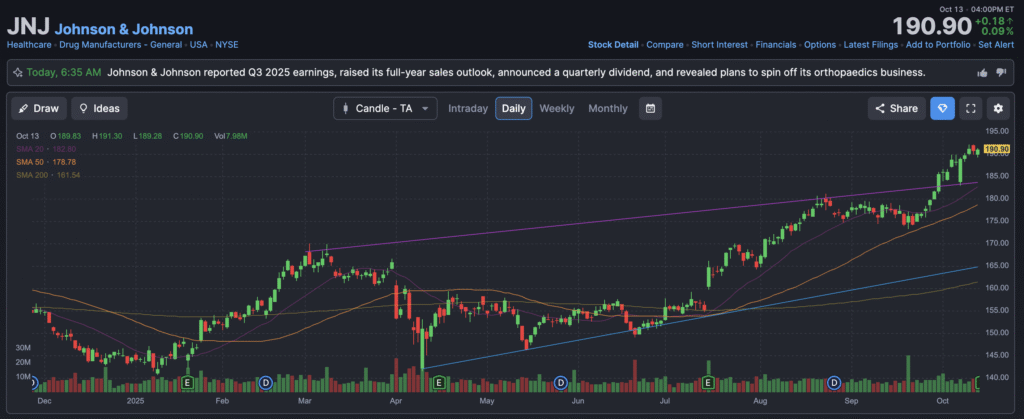Johnson & Johnson is a large, diversified healthcare conglomerate operating across pharmaceuticals, medical devices, and (formerly) consumer health products. Its scale, global reach, and diversified exposure give it resilience across cycles. The company invests heavily in R&D and has a strong product pipeline, especially in immunology, oncology, and medical devices. Over time it has pursued portfolio simplification via spin-offs (e.g. consumer health) and refocusing on higher growth, higher margin segments. Despite legacy legal and regulatory risks (e.g. talc litigation), J&J is often viewed as a defensive, dividend-oriented stock in the healthcare space.

2. Most Recent Earnings
In the 2025 third quarter, J&J reported sales of $24.0 billion, up 6.8% year over year, with operational growth of ~5.4% and adjusted operational growth ~4.4%. The adjusted EPS was $2.80. Compared to consensus estimates of ~$2.76, the result was modestly above expectations. As a result, J&J raised its full-year product revenue guidance (to $93.5 b–93.9 b, ~ +300 m over prior) and maintained or modestly tightened its EPS guidance (midpoint ~$10.85) for 2025. Additionally, the company announced plans to spin off its orthopedics business (“DePuy Synthes”) over the next 18–24 months, affecting ~ $9.2 b of revenue (≈10% of total) to sharpen focus on core segments.
3. History, Founding, Products, Headquarters & Competitors
Johnson & Johnson was founded in 1886 by Robert Wood Johnson and his brothers in New Brunswick, New Jersey. Over its long history, J&J has grown by internal innovation and acquisitions across pharmaceutical, devices, and consumer health lines. Its headquarters remain in New Brunswick, NJ (with major operations globally).
J&J’s product portfolio spans:
- Pharmaceutical / Innovative Medicines: immunology, oncology, neuroscience, vaccines, etc.
- Medical Devices / MedTech: orthopedics, cardiovascular devices, electrophysiology, surgical equipment, etc.
- (Previously) a large Consumer Health division (wellness / over-the-counter / personal care), which has been spun off into Kenvue (completed in 2023).The company has also engaged in acquisitions (e.g. Intra-Cellular Therapies) to bolster its pipeline.Key competitors include Pfizer, Merck, Bristol Myers Squibb, AbbVie, Medtronic, Boston Scientific, Stryker, Zimmer Biomet, and others in overlapping therapeutic or device spaces.
4. Market / Industry Landscape & Growth Expectations
J&J operates in the broader pharmaceutical / biotech / medical device ecosystem. These are large, mature markets with structural tailwinds (aging populations, increasing chronic disease burden, innovation in biologics, minimally invasive devices, digital health).
J&J’s corporate long-term guidance envisions operational sales CAGR of ~5-7% for 2025–2030, with the Innovative Medicines segment expected to grow similarly, and MedTech in upper range of its markets. The company anticipates launching 10+ assets with peak sales potential > $5 b and another ~15+ in the $1–5 b range.
Device markets (e.g. electrophysiology, cardiovascular, robotics) are projected to grow in mid single digits, partly driven by procedural demand, demographics, and new modalities (e.g. robotic surgery).
Thus, by 2030, J&J aims to remain a leader in large addressable markets with a composite growth trajectory in the 5–7% CAGR range.
5. Competitors
In pharmaceuticals / biotech: Pfizer and Merck are major peers in drugs and vaccines; Bristol Myers Squibb (BMS) and AbbVie compete in overlapping therapeutic areas (immunology, oncology).
In medical devices: Medtronic, Boston Scientific, Stryker, Zimmer Biomet, Intuitive Surgical (in robotic / surgical systems) are among the key competitors.
These firms may outperform in niche areas (e.g. Medtronic in cardiac devices, Intuitive in robotics), but lack J&J’s broad vertical span across pharma + devices + consumer (though consumer is now spun off).
6. Unique Differentiation
J&J’s differentiation lies in its diversification across pharma and devices, which offers some hedge across cycles and therapeutic regimes. Its scale allows it to invest heavily in R&D and absorb failures. Its ability to spin off non-core units (e.g. consumer health, orthopedics) demonstrates portfolio discipline toward higher growth segments. Additionally, J&J’s pipeline depth—particularly in biologics, immuno / oncology, neuroscience—and its capability to integrate devices + therapeutic combos (e.g. drug + device systems) is harder for pure-play peers to replicate. Its longstanding relationships with hospitals, regulatory expertise, and global footprint further bolster defensibility.
7. Management Team
- Joaquin Duato – CEO & Chairman. Duato became CEO in early 2022; he had been part of the J&J executive suite, overseeing pharmaceuticals and operations prior.
- Joseph Wolk – CFO. He oversees finance, accounting, capital allocation, and has led guidance and forecasting.
- Jennifer Taubert (or other divisional head) – she has been a senior executive overseeing the pharmaceuticals / R&D side (in past roles).These executives combine long tenure, internal experience, and continuity in executing on transformation (spin-offs, pipeline focus).
8. Financial Performance Over the Past 5 Years
Over the past five years, J&J’s revenue growth has been modest. In 2024, its annual revenue was ~$ $88.821 billion (up ~4.3% from 2023). In prior years, growth was more variable: 2023 revenue ~$85.16 b (6.46% growth over 2022) . According to data, J&J’s 5-year revenue CAGR is ~2% (versus 3-year ~7%) per some sources.
Earnings (net income, adjusted EPS) have also faced pressure due to margin squeezes, legal charges, and competitive pressures. Over this period, EPS growth has been uneven but with resilience in profitability, supported by cost discipline, divestitures, and operating leverage.
On the balance sheet, J&J maintains a strong financial position: moderate leverage, strong cash flow generation, and capacity to invest or acquire. It has historically maintained investment-grade credit ratings, healthy liquidity, and flexibility in capital allocation (dividends, buybacks, M&A).
With the recent spin-off moves, the company is reshaping its balance sheet allocation and focusing capital on higher return segments.
9. Bull Case
- Continued strong execution of spin-outs (consumer health / orthopedics) will sharpen focus and margins in core growth segments.
- A deep pipeline in immunology, oncology, neuroscience and device innovation could drive blockbuster launches and upside surprises.
- Its stable dividend, cash flows, and defense during downturns make it attractive to income and core healthcare investors.
10. Bear Case
- Legacy litigation risk (e.g. talc cases) and regulatory scrutiny could impose large, unpredictable liabilities.
- Patent expirations, biosimilar entry, and pricing pressures may compress margins in key drug franchises.
- The spin-off transitions could be distracting, and misexecution may result in disruption or dilution of core business performance.

The stock is in a stage 2 bullish markup on all 3 timeframes and should get to $200 after a consolidation in the near term to the $185 mark.